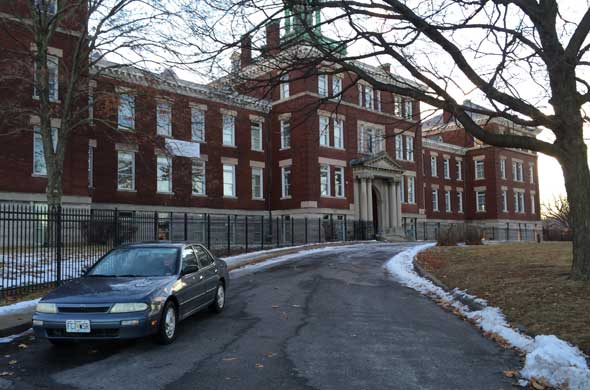
by Joe Montanari (reprinted from the West Plaza neighborhood newsletter)
Traveling east or west on 39th Street, on the southwest corner of 39th and Roanoke Road, one notices a handsome old building known as “The Loretto.” It’s a little tricky to see out the car window as you drive by, but if you approach from the north, coming up the hill on Roanoke Road, you can get a wonderful panoramic view.
This lovely building, dedicated in 1904, was designed by architect Thomas P. Barnett, who won the gold medal for architecture for designing the Palace of Liberal Arts for the 1904 St. Louis World’s Fair. After working on the Loretto, Barnett went on to design the Cathedral Basilica in St. Louis and a number of other important structures, before becoming an accomplished impressionist painter in later years. His paintings may be seen at both the Missouri State Capitol and the St. Louis Art Museum.
Today, with meeting rooms and dining halls, the Loretto serves as a venue for wedding receptions and parties and other functions.
For its first eighty years, however, the building and grounds were the home of the Loretto Academy, “a boarding and day school for girls.” The school was named after the Sisters of Loretto, a community of Catholic nuns, who came to Kansas City from Hardin’s Creek, Kentucky, in 1899 at the invitation of Bishop John Hogan. Ordained in St. Louis in 1852, Father Hogan had begun his religious career as a missionary to slaves working the lead mines in Potosi and Old Mines, Missouri.
The order of the Sisters of Loretto was founded in 1812, for the purpose of “bringing education to the poor children of the frontier.” The order shared Bishop Hogan’s sense of social justice and later established a mission to the Osage Nation in Oklahoma.
That sense of social justice was sorely tested in September of 1947, when Loretto Academy admitted its first black student, Carmen Forte, the gifted 15-year-old stepdaughter of attorney (later Judge) Lewis Clymer. Clymer wanted his daughter to attend college, but the school she attended was unaccredited. On her first day at Loretto, Carmen and her stepfather walked up the front steps, only to be confronted by a small group of angry parents. Twenty-five students were removed from Loretto that day, five years before the historic Brown v. Topeka case desegregated schools once and for all. Carmen went on to graduate from Loretto in 1949 and had a successful career with the Carter Broadcasting Company.
By the 1960s Kansas City’s suburbs were drawing the population south, and the school moved to 124th and Wornall, where it remained until it closed in 1984. The old school building went through a series of owners and foreclosures, but fortunately was added to the National Historic Register in 1983.
Beautifully restored by its current owners in the 1990s, the stately building on 39th Street reminds us of a hardy band of dedicated pioneer women dedicated to education, human rights, and the empowerment of women.
Sources: Marty Denzer and the Catholic Key, the Kansas City Public Library Missouri Valley Collection and Wikipedia.
Pingback: What happened last week in Midtown Kansas City? - Midtown KC Post | Midtown KC Post
Pingback: Dallas developer wants The Loretto to be THE authentic Kansas City hotel experience | Midtown KC Post
Pingback: This Volker block was home to hard-working laborers - Midtown KC Post